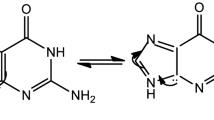Abstract
Water-soluble vitamins, amino acids, and nontoxic pharmaceutical excipients were studied as solubilizing agents for poorly water-soluble adenine (nucleic acid base), guanosine (nucleoside), and structurally related drugs (acyclovir and triamterene). The apparent solubility of the substrates (adenine, guanosine, acyclovir, or triamterene) was appreciably increased by forming complexes with the ligands (vitamins, amino acids, or other ligand). Apparent association constants (K a ) values were measured at 25°C in pH 7 phosphate buffer using phase solubility analysis. The effect of combination ligands on substrate solubility was also studied. Additive solubility enhancement was obtained for several ligand pairs.
Similar content being viewed by others
REFERENCES
J. Truelove, R. B. Nassar, N. R. Chen, and A. Hussain. Solubility enhancement of some developmental anti-cancer nucleoside analogs by complexation with nicotinamide. Int. J. Pharm. 19:17–25 (1984).
H. J. Schaeffer. Nucleosides with antiviral activity. In J. L. Rideout, D. W. Henry, and L. M. Beachman (eds.), Nucleosides, Nucleotides and Their Biological Applications, Academic Press, New York, 1983, pp. 1–17.
M. Mahmoudian. Quantitative structure-activity relationships (QSARs) or pyridine nucleoside as HIV-1 antiviral agents. Pharm. Res. 8:43–46 (1991).
R. A. Kenley, S. E. Jackson, J. S. Winterle, Y. Shunko, and G. C. Visor. Water soluble complexes of the antiviral drugs, 9-(4,3-dihydroxy-2-propoxy)methylguanine and acyclovir: the role of hydrophobicity in complex formation. J. Pharm. Sci. 75:648–653 (1986).
T. Higuchi and S. Bolton. The solubility and complexing properties of oxytetracycline and tetracycline III. J. Am. Pharm. Assoc. Sci. Educ. 48:557–564 (1959).
S. P. Shah and D. R. Flanagan. Solubilization of salicylamide and acetaminophen by antihistimines in aqueous solution. J. Pharm. Sci. 79:889–892 (1990).
T. Higuchi and K. A. Connors. Phase solubility techniques. Adv. Anal. Chem. Instrum. 4:117–212 (1965).
A. J. Repta. Alteration of apparent solubility through complexation. In S. Yalkowsky (ed.), Techniques of Solubilization of Drugs, Marcel Dekker, New York, 1981, pp. 135–149.
T. Higuchi and H. Kristiansen. Binding specificity between small organic solutes in aqueous solution: Classification of some solutes into groups according to binding tendencies. J. Pharm. Sci. 59:1601–1605 (1970).
Author information
Authors and Affiliations
Rights and permissions
About this article
Cite this article
Chen, A.X., Zito, S.W. & Nash, R.A. Solubility Enhancement of Nucleosides and Structurally Related Compounds by Complex Formation. Pharm Res 11, 398–401 (1994). https://doi.org/10.1023/A:1018913104383
Issue Date:
DOI: https://doi.org/10.1023/A:1018913104383




